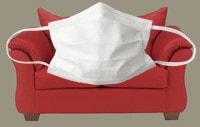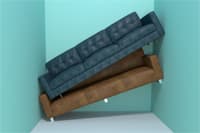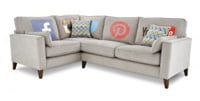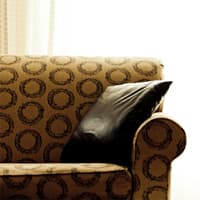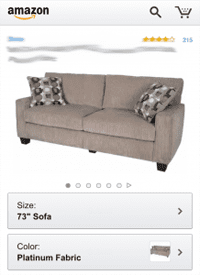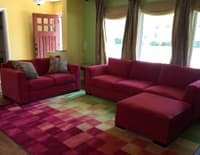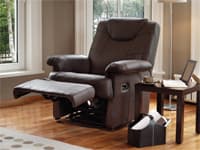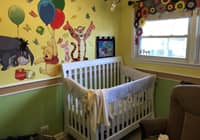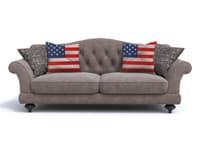
Furniture Industry Posts
With over 60 years experience in the furniture industry, and over 30 years factoring for the furniture industry, no one knows furniture better than DSA Factors. Stay on top of furniture industry news by reading the Factoring 101 Blog.
Jump to a Post
The Changing Furniture Landscape
Over the past decade we have slowly been watching the retail landscape transform from traditional brick and mortar stores to online shopping. However, as a result of the COVID-19 pandemic, 2020 not only experienced the greatest shift towards online shopping, but for the first time direct-to-consumer e-commerce sites have taken the largest share of the furniture market. After leading in growth rate for the past seven years, these online retailers grew by an incredible 47% in 2020. According to Furniture Today, online retailers now have a 20.8% market share of the furniture market, where traditional furniture stores only have a 20.5% market share. After that, lifestyle furniture stores have a 14.3% share of the market, discount department stores have a 13.4% share, manufacturer-branded furniture stores have a 11.5% share, bedding specialists have a 8.7% share, warehouse clubs have a 7.4% share, and finally rental centers only have a 3.4% share. This shifting marketplace can be seen by taking a look at the top 10 furniture retailers for 2020.
Leading the change in direct-to-consumer was Wayfair, which supplanted Ashley HomeStore as the number one furniture store in terms of total sales, ending an 11-year streak of Ashley holding the top spot. However, Wayfair didn’t just sneak past Ashley but rather skyrocketed past them. Wayfair’s furniture sales were over $6.66 billion in 2020, a 54% increase over 2019’s $4.34 billion in sales. Ashley on the other hand was much more stable with sales growing from $4.75 billion in 2019 to $4.8 billion in 2020, while adding 30 more stores to their retail footprint.
The other huge increase was made by Amazon who knocked Walmart out of the number 3 spot for total furniture sales. Amazon experienced 38% growth in furniture as sales increased from $3.16 billion in 2019 to $4.37 billion in 2020. Walmart, who in addition to their large retail footprint also sells online, only experience 9% growth in furniture as sales increased from $3.19 billion in 2019 to $3.48 billion in 2020. Of course, unlike Wayfair and Ashley where furniture makes up the majority of their total sales volume (56% for Wayfair and 95% for Ashley), furniture makes up a trivial percentage of both Amazon and Walmart’s total sales. Furniture accounted for only a little over 1% of Amazon’s total sales, and for less than 1% of Walmart’s total sales.
Remaining in the number 5 spot was Mattress Firm, the only bedding specialists to make it into the top 10. Mattress Firm experienced 10% growth with sales rising to $2.95 billion despite reducing their retail footprint by over 3%.
For the number 6 spot, Rooms To Go passed IKEA as their sales grew by 11% to reach $2.79 billion. IKEA actually experienced a nearly 8% decline in sales. There total sales were $2.51 billion in 2020, which places them at number 7.
Costco just barely jumped ahead of Williams-Sonoma to claim the number 8 spot after experiencing 28% growth in 2020. Williams-Sonoma didn’t do bad however, their sales grew by 20% in 2020. Both companies had approximately $2.44 billion in furniture sales, although It is important to note that furniture only accounts for 1.5% of Costco’s total business, while it accounts for about 36% of Williams-Sonoma. Costco’s overall sales increased by 9% as they expanded their footprint by 7%. Williams-Sonoma saw their overall sales increase by 23% as they actually reduced their retail footprint by 5%.
To round out the top 10 came another big winner of 2020, Target jumped up 4 spots since 2019 to claim the number 10 spot. Their furniture sales increased by 28% to hit $1.99 billion in 2020. Furniture only accounts for approximately 2% of Target’s total sales, which rose by a similar 29%.
What’s perhaps most interesting here is the fact that the top 10 furniture retailers experienced 19.5% growth in 2020, a year that was defined by lockdowns and a devastated economy. At the same time, Wayfair, Amazon, Walmart, and Target are four of the nation’s largest online retailers, while Walmart, Costco, and Target were all deemed essential businesses and remained open throughout the entire pandemic. It should come as no surprise that direct-to-consumer retailers experienced 47% growth in 2020, while warehouse clubs experienced 21% growth, and discount department stores experience 14% growth. Traditional furniture stores only experienced 2.2% growth in 2020 while manufacturer-branded stores only had 1.7% growth. The big loser of 2020 however was rental stores who saw sales slide by an incredible 34%.
Whether or not these trends continue in 2021 remains to be seen. It is clear that this pandemic is far from over, but it seems unlikely that we will be seeing any additional lockdowns for the remainder of the year. It seems unlikely that the big winners of 2020 will see sales numbers decline, although they also may not grow as quickly as they had over the past year. We also don’t know if regular furniture sales will start to see increasing sales again this year, or if the rental sector will bounce back. It is possible with 2021 still being defined by the pandemic that we won’t start to see change until 2022 or later.
What this means for the furniture industry is that selling to major retailers, especially online retailers is more important than ever. In analyzing our data over the past year and a half, it was very clear that most of our clients who were selling to the correct places (Wayfair, Amazon, Walmart, Target, TJX, and Costco) had a very good 2020, while most that sold primarily to normal furniture stores saw sales slide in 2020.
Of course, getting into the major retailers isn’t easy, and should you get in, coming up with the finances to support large orders could present an even greater challenge. At DSA Factors, we can help. With our roots in the furniture industry going back over 60 years, there is no other factoring company who understands the furniture industry as well as we do. We can provide you with purchase order financing and accounts receivable factoring, so that you will have the financial ability to take on any sized order. If you are looking to grow your business in 2021, give DSA Factors a call today at 773-248-9000, email us at info@dsafactors.com, or chat with us right here on this website. At DSA Factors, we have money to make your company grow!
COVID-19’s Effect on the Furniture Industry
The COVID-19 pandemic has had an incredible effect on the furniture industry. While some retailers that sell furniture have been deemed essential businesses and have been allowed to continue operations through stay-at-home orders, most have either been forced to close or voluntarily closed. The same is true of furniture wholesalers, although for many wholesalers they have the luxury of being able to do most of their work from home, something that is not possible for their customers in retail. While DSA Factors has been providing updates on the small business community throughout the COVID-19 pandemic, one of our largest areas of specialization is in furniture, so it made sense to report on the status of the furniture industry at this time. Therefore, we have decided to use our data to give a report on the state of the furniture industry at this time.
For the start of the year it was pretty much business as usual for the furniture industry. Even though the COVID-19 virus was spreading across China at the start of the year, it didn’t seem to have any impact on the furniture industry in America. Part of the reason may be that the Chinese New Year holiday took place as the virus first started spreading, and factories are normally shut down for several weeks during the holiday period. In fact, it was business as usual for the first 3 weeks of March as well. While the NBA suspended their season on March 11th, and the other sports quickly followed suit, the guidance at that time was simply to avoid large gatherings. It wasn’t until March 19th that California issued the nation’s first statewide stay-at-home order, which was quickly followed by Illinois on the 21st and New York on the 22nd.
The fourth week of March, after millions of Americans were ordered to stay at home, we saw a drastic decline in the furniture industry with over one third of furniture wholesalers closing up shop that week. At the same time, sales, which had remained steady up until that point, were down by 70% that week. As April began, more and more furniture wholesalers started closing their businesses, although sales have remained steady at 70% below normal levels throughout April. As of today, a little less than a third of furniture wholesalers are still doing business.
However, there is one sector of the furniture industry that hasn’t been hit as hard during this pandemic, that is the casual furniture sector. As the weather start warming up and people are forced to stay at home, the casual furniture sector is expecting to see some large sales numbers as people start to invest in their own backyard more and more. While many casual furniture retailers remain closed, they are still placing orders as they are very optimistic that many Americans are going to want to make their own outdoor spaces more comfortable.
While it would be a lie to say that the casual furniture sector has not been hurt by the COVID-19 pandemic, it is doing much better than the furniture industry as a whole. Just like the entire furniture industry, the third week of March was the last week of business for a third of casual furniture wholesalers. However, half of casual furniture wholesalers remain open and are still doing business today. While the last week of March saw sales drop by 75% for casual furniture wholesalers, those sales numbers have been improving throughout April and are now at normal levels.
For retailers, those who are in casual furniture seem to doing better as well. Furniture retailers in general started having trouble paying for merchandise that was invoiced during the final week of February. This makes sense as these invoices would have become due in the final week of March as stay-at-home orders were being put into place and many retailers were forced to close their doors. For merchandise that was invoices in March, 60% of it has not been paid yet. However, retailers in the casual furniture sector have been doing better. Casual furniture retailers are about a week ahead on their payments with most invoices from February having been paid, and only 50% of merchandise invoiced in March remaining unpaid. Only time will tell if these trends hold up, but for now it seems like the casual furniture sector is doing alright.
DSA Factors continues to monitor the COVID-19 pandemic’s impact on the economy. Check back regularly for more updates in the future. Stay safe and stay healthy.
DSA to Attend Home Furnishings Manufacturing Solutions Expo
DSA Factors has always been committed to serving the furniture industry, so this year we will be traveling to Hickory, NC to attend the Home Furnishings Manufacturing Solutions Expo. The show will be taking place July 17-18 at the Hickory Metro Convention Center.
This is the third year of the show with previous shows having taken place in Atlanta, GA and Greenville, SC. There will be a wide range of exhibitors at the expo including machinery, software, logistics, and of course factoring. DSA Factors is excited about being a part of this year's expo.
Whether you are one of our clients, a prospective client, or simply want to learn more about accounts receivable factoring and purchase order financing, please stop by booth 1322 and Ben and Max will be happy to speak with you. As a courtesy to all of our guests, you may register for the show using promo code DSA19 to receive a free badge.
We look forward to seeing you this July in Hickory!
How Would an Amazon Furniture Store Impact the Furniture Industry
Amazon is already a retail giant, but up until recently all of their sales have existed only online. However, that is slowly changing. In November 2015 Amazon opened its first brick and mortar bookstore in Seattle, and has opened a handful more across the country in the last year. They also started experimenting with cashier-less grocery stores at the end of last year. Of course the big news came a couple of weeks ago when Amazon announced they would be purchasing Whole Foods for $13.7 billion. While Amazon is yet to open a brick and mortar furniture store, there have been reports that they are looking into doing so. If, or when, they do open a furniture store, you can bet that it will have some pretty dramatic effects on the furniture industry.
Amazon and the Book Industry
Amazon of course started off as an online book store back in 1995 and didn't turn a profit until 2001. The impact that Amazon has had on the book industry has been dramatic. They drove Borders, a 500+ store chain and former Amazon partner, out of business in 2010. Barnes and Noble has survived but is struggling. So it is interesting that the company that has been responsible for closing hundreds of bookstores around the country, and has no problem selling books online, would want to open up their own bookstores. Of course, for a company like Amazon, the cost of opening up a bookstore is insignificant, and it could be worth it to Amazon to open these stores even if the stores themselves are not profitable since they can be used as market research and for marketing Amazon's other services such as Prime. The fact that these bookstores are popping up slowly and only in several cities may indicate that indeed the stores are not profitable on their own.
Amazon and the Grocery Industry
Groceries, however, unlike books, have been a much bigger problem for Amazon. While non-perishable foods can be shipped, they are also heavy and shipping them can be expensive. Of course fresh produce is much more problematic, not only does it have a short shelf life, but most consumers wouldn't want someone else picking out which bananas or cut of meat they are purchasing. Then you have refrigerated or frozen foods, if it took Amazon two days to deliver your milk, it would go bad long before it arrives at your doorstep. At the end of last year Amazon started experimenting with several grocery store concepts in Seattle. Amazon Go offered cashier-less convenience stores. You simply walk in, take the food you want, and walk out, with your credit card automatically getting billed. Amazon Fresh Pickup allows customers to order food online and then pick it up at a nearby drive-thru. While Amazon Fresh Pickup still doesn't address the issue of allowing consumers to pick their own produce, it at least addresses the issue of short shelf life and refrigeration. But just like with bookstores, which also started out in Seattle, these stores are being rolled out slowly and Amazon still has an insignificant market share of the grocery industry.
That of course has all changed with Amazon's buyout of Whole Foods and its 460+ stores across the nation. In a matter of seconds Amazon made a major move not just into the grocery industry but into brick and mortar retail. They instantly gained hundreds of locations around the country where customers can pick up orders, drop off returns, and do their shopping all at the same time. They also can roll out some of their new technologies on a much larger scale than they have done so far.
Amazon and the Furniture Industry
The Challenges of the Furniture Industry
With Amazon apparently solving their grocery problems, that leaves only one other industry where Amazon is struggling to get their foot in the door, the furniture industry. While furniture may not go bad like fresh fruit and vegetables, it has its own challenges. First of all, it is a major purchase, even the cheapest pieces will cost you at least a hundred dollars, and if you are updating a room you can expect your bill to be in the thousands. When making such a large purchase consumers are going to take their time to shop around to make sure that they are getting exactly what they want. In the case of upholstery and bedding, consumers need to touch and feel the product to make sure that it is comfortable. Furthermore, many furniture purchases are custom orders where the consumer picks the colors and finishes they want. As a result retailers are not able to stock the merchandise but instead need to order it, meaning it could take anywhere from 4-12 weeks for the consumer to receive the merchandise. This doesn't work well with Amazon's goals of reducing delivery time from two days to two hours. But of course the largest problem with furniture is delivery. Furniture is bulky, heavy, and easily damaged. While it can easily be transported to distribution centers and stores, it is delivering it the final mile into the consumer's home that presents the greatest challenge, along with assembly for items such as beds that would not be able to fit through doorways if they were delivered fully assembled.
How does Amazon Enter the Furniture Industry?
So of course the next question is what will Amazon do? Amazon has committed to selling furniture; they have opened up showrooms in both Las Vegas and High Point. While it is possible that Amazon may experiment with opening its own stores, it is likely that when they are ready to make the jump into brick and mortar furniture, they will buyout a furniture retailer. Of course, there are very few furniture retailers that have locations nationwide like Whole Foods, but Amazon doesn't necessarily need to purchase a furniture retailer. Purchasing a department store might make greater sense as they are larger, have more locations, and would allow Amazon to sell other merchandise that is difficult to sell online, such as appliances and clothing.
If you start looking at department stores, Amazon has a lot more opportunities as many of the department stores are struggling, mainly due to having to compete with Amazon and other online retailers. Purchasing Macy's would give them access to 800+ locations around the country. JC Penny would give them over 1000 locations. But most interesting is perhaps the department store that has told its investors that it may not be able to keep its doors open. If Amazon were to buyout Sears, not only would they be able to purchase it at a bargain price, but they would immediately have access to over 1500 retail locations and a wealth of real estate all around the country.
Of course all of this is just speculation, what isn't speculation is that Amazon is going to do something in the furniture industry. There is talk of them using technologies such as virtual reality or augmented reality so that you can picture what a particular piece of furniture would look like in your home. Another possibility is offering delivery windows within hours of when you make a purchase in their store. But whatever they do, it is going to be big and everyone is going to have to keep up with Amazon if they don't want to lose out.
What will be Amazon's Impact on the Furniture Industry?
FURNITURE RETAILERS
While retailers will face stiffer competition, they may also benefit from the new technologies that Amazon brings to the industry. If existing furniture stores are able to adopt Amazon's technologies, they too could use those technologies to increase sales. Of course, the real advantage to traditional retailers comes in the area of customer service. A company like Amazon will never be able to provide personalized service and most likely wouldn't have trained salesmen who know about all the products in their store, instead they will probably rely on Amazon reviews like they do in their bookstores, and perhaps a specific customer's buying trends. While Amazon may already know if a customer is looking for a more traditional or contemporary look based upon their online purchasing patterns, a traditional salesman can simply ask the customer what they are looking for and forget about all the algorithms. By offering exceptional customer service and a knowledgeable staff, current furniture retailers should be able to compete with Amazon and would definitely do better in customer retention.
FURNITURE VENDORS
From a vendor's point of view, Amazon stores can potentially open up more possibilities. Smaller vendors, who have trouble getting floor space in the showrooms of larger furniture retailers, may have an easier time getting floor space in an Amazon showroom. While certainly Amazon could offer everything online, it will be limited in what they can display in their showroom by the amount of real estate they have. Unlike traditional furniture retailers who buy from a handful of vendors, Amazon purchases from everyone and that of course is what sets them apart.
If Amazon's bookstores are any indication of how they do business, products that perform better online will have the upper hand. At Amazon bookstores there is a very limited selection of books, and the selection is not based on which books Amazon's buyers feel should be on the shelves. Instead the book selection is all determined by algorithms which look at sales volume and customer reviews of each book. As a result, a category that has a more limited selection but sells modestly well may get more shelf space than a hugely popular category that offers a much wider variety of books to choose from. For example, Amazon bookstores have an excellent selection of recipe books which individually sell well online, but a very limited selection of fiction, a category that performs incredibly well as a collective group, but not as individual titles. Furthermore, where a traditional bookstore will feature every book that Dr. Seuss ever published in their children's department, Amazon bookstores would probably only have one or two of his books that sell extremely well online, if any. There is no reason to believe that Amazon wouldn't take the same approach in a furniture showroom.
This could be huge for niche manufacturers. While overall your sales volume may look insignificant when compared to someone like Ashley, if you have a single unique product on the market that sells very well, it is quite possible that it would get floor space in an Amazon showroom. While Ashley may offer 1000 different products, it means that each product only gets a thousandth of Ashley's overall sales volume, and your single product receives 100% of your sales volume. As a result, your single product would have better sales numbers than any individual Ashley product, and if it receives positive customer reviews, it would perform better in Amazon's algorithms.
If there is any lesson to be learned from this, it is quite simple, online matters. If you don't want to get left behind, you need to bring your business online, and the more you offer the more you have to gain. Getting sales and positive reviews right now on Amazon could result in even greater sales volumes in the future when Amazon starts opening brick and mortar stores. If you are looking to get your product for sale online, DSA Factors is here to help. We provide factoring for Amazon receivables, as well as Wayfair, Hayneedle, One Kings Lane, Zulily, and many other online stores. Give us a call today at 773-248-9000 to learn more about how DSA Factors can help you grow your online business.
Most Popular Rooms in a Home
When deciding a product that people will use in their home, it is important to understand how people use their homes. Whether you sell furniture, housewares, or giftware, your product needs to fit into your consumer's lifestyle if you want it to be a success. With the average home containing seven rooms, tailoring your product to fit into a heavily used room could lead to increased sales. A recent survey conducted by Furniture Today gives a pretty good picture of which rooms people find to be most important.
Most Popular Room to Spend Time in
It should come as no surprise, but . Nearly half of all people asked stated that they spend the most time in their living room. As a result over a third of consumers would like to get new furniture in their living room than in any other room in their house. While you may think that a third is low, it is important to consider that the living room is where we spend our waking hours, but that we sleep in our bedrooms. However, sleeping isn't all we do in the bedroom, nearly half of all people charge their electronic devices, such as phones, in their bedroom, and 15% of consumers surveyed said that they spend more waking hours in their bedroom than anywhere else in the house. As a result, a quarter of all consumers would prefer to purchase new furniture for their bedroom over any other room in their house.
Other popular rooms to spend time in include the den, where another 15% of people say that they spend the most time. Home offices are most popular with 10% of people, and kitchens are most popular with 8%. However, only 1% of people say they spend the most amount of time in the dining room, and another 1% say they spend the most amount of time on their patio, deck, balcony, or other outdoor spaces.
Where do you Eat?
Of course, it isn't just about where we spend time in our home, but also what we do in our homes. Eating, of course, is the one thing that everyone will do inside of their home, and if you sell dinette sets, tableware, silverware, or any other product that people use when they eat, you might want to take into consideration where people prefer to eat their meals before you design your next product.
When it comes to eating as an entire family, the dining room and kitchen are the most popular places to eat. 35% of families say they prefer to eat in the dining room, while 34% say that they prefer to eat in the kitchen. You may be surprised however that 22% of families eat most of their meals together in the living room.
When it comes to where you eat breakfast, lunch, and dinner, the numbers aren't all that different. The kitchen is the most popular room for breakfast and lunch, while dining rooms are the most popular (but just barely) for dinner. The kitchen is easily the room of choice for breakfast with 44% of people naming the kitchen as where they usually have their cereal and milk, that number drops to 35% at lunchtime, and drops even further to 29% at dinnertime. While you may think that this is because the dining room becomes more popular as it gets later in the day, that actually isn't true. The dining room is most popular with 23% of people at breakfast time, but only 22% of people at lunchtime. The dining room however gets its most use at dinnertime with 30% of people stating it as their room of choice. So it is actually the living room that becomes the most popular place to eat as it gets later in the day. Only 18% of people say they prefer to eat breakfast in their living room, but that number jumps to 23% at lunchtime, and up to 28% at dinnertime.
While the kitchen, dining room, and living room are the most popular places to eat, they aren't the only place to eat. You've probably heard of breakfast in bed, and 4% of people say they prefer to eat breakfast in their bedroom, but you may be surprised that that same 4% also prefer to eat dinner in their bedrooms, while 3% prefer to eat lunch in their bedroom. Other rooms where people eat include the den, which is the room of choice for about 6% of people. About 3% of people like to eat in their home office, with lunch being the most popular meal there. You may be surprised, but only 1% of people prefer to eat their meals outdoors, and this was a nationwide survey that questioned people in both warm and cold climates.
Funding your Product for the Home
Of course, it is one thing to have a great design for a product for the home, it is another thing to have the proper financing in place in order to produce and sell that product. If you are struggling to get your business off the ground, or you are experiencing rapid growth, accounts receivable factoring may be the solution you are looking for. Unlike a loan from a bank, accounts receivable factoring is fast and easy, and rather than looking at your credit and past sales, factoring companies look at your customers good credit. If you don't qualify for a loan with a bank, or the bank can't provide you with a large enough credit line, give DSA Factors a call at 773-248-9000 and with one simple phone call we can start funding your business in as little as 24 hours. There is no obligation or long term commitment, and the funds you receive from DSA Factors are not a loan. So call today and learn just how easy it is to grow your business with accounts receivable factoring.
2016 Furniture and Bedding Sales Top $100 Billion for Second Straight Year
2016 saw furniture and bedding sales climb to $104.8 billion, a 2.7% increase over 2015's $102 billion. This is not just the second straight year that furniture and bedding have reached the $100 billion mark, but it is also the second straight year that they have been above pre-recession levels. Furniture sales had been at $100.8 billion in 2007 before dropping to $83.2 billion by 2009.
While furniture sales have been gradually increasing every year since 2009, 2016 only experienced modest growth. The 2.7% increase is the second lowest during this time period, only 2013 saw slower growth at 1.8%. All other years have experienced over 3% growth, with 2012 experiencing 4.5% growth.
This increase in furniture spending correlates well with other economic data. Last year median household incomes had risen by 5.2% and was at $56,516 in 2015. However this is still below pre-recession levels; median household income was at $57,423 in 2007. Home sales have also gone up with September 2016 experiencing nearly 30% more sales than September 2015.
As for distribution channels, nothing much had changed in 2016. In fact the only change came from online sales, which accounted for 10% of furniture and bedding sales in 2015, now accounted for 11% of sales in 2016, which is $11.5 billion. Wayfair accounted for most of this growth with an amazing 70% increase in sales that brought their totals to $1.26 billion.
When it comes to different segments, area rugs are by far the fastest growing segment. 2016 sales increased to $5 billion, a 4.2% increase over 2015's $4.8 billion. Casual furniture also did well growing from $4.4 billion in 2015 to $4.53 billion in 2016, a 3.1% increase. Entertainment furniture did similarly well growing from $6.66 billion in 2015 to $6.86 billion in 2016, also a 3.1% increase. Bedding however isn't growing quite as quickly as the rest of the furniture industry. Bedding, which accounts for 15% of all furniture sales grew from $15.09 billion in 2015 to $15.41 in 2016, only a 2.1% increase. All other furniture segments showed growth similar to the industry average.
According to economic projections by Furniture Today, assuming no major changes occur to the economy, furniture and bedding sales are expected to rise to $127 billion dollars by 2021, a 21% increase over the next five years. As the furniture and bedding industries continue to grow, if you are having trouble keeping up then accounts receivable factoring may be the solution you are looking for. With accounts receivable factoring you get funded for your invoices the same day the merchandise ships, giving you the cash flow you need to grow your business. DSA Factors has been providing accounts receivable factoring for the furniture and bedding industries for over 30 years. During that time we have provided hundreds of companies with the cash flow that they need to grow their business. So what are you waiting for, give us a call at 773-248-9000 and start getting funded tomorrow for your invoices.
Living Rooms are the Most Popular Room for an Area Rug
While area rugs are becoming increasingly popular and can be found all around the house, they are most commonly found in living rooms. 44% of all homes have an area rug that is 5-by-8 or larger in their living room, making it the most popular room in the house for a rug. Living rooms are followed by master bedrooms, which feature a large area rug 20% of the time, and by dining rooms, where you can find an area rug 19% of the time.
You will see an area rug in a family room or den 13% of the time, however among affluent households who make more than $100,000 a year, that figure rises to 25%. Children's bedrooms contain area rugs 9% of the time, and it should come as no surprise that this figure rises to 18% among Millennials who are most likely to have children living at home. Only 8% of kitchens, 6% of guest bedrooms, and 4% of home offices feature area rugs. 6% of other rooms have area rugs, this includes play rooms, bathrooms, hallways, laundry rooms, sun rooms, outdoor rooms, closets, and more.
When it comes to colors, browns and beiges are the most popular accounting for over a quarter of all rugs. Blacks and grays come next accounting for a little more than a fifth of all rugs. This is followed by blues and purples which account for a seventh of all rugs and multi-colored rugs account for an eighth of all rugs. Greens, reds, and whites each account for about one in twenty rugs. Yellows and golds are slightly less popular than one in twenty, and oranges only show up in about one in fifty rugs.
As for shape, a whopping 90% of all area rugs are rectangular. Runners account for only 4% of the rug market. After that only 3% of rugs are circles, 2% are squares, and 1% are oval.
When it comes to shopping for area rugs, online is the way to go. Seven in ten consumers shop online while only a little more than four in ten consumers will visit a brick and mortar store. Of those who shop online, four in five consumers will compare prices with most preferring to do so with online-only retailers. A quarter of consumers will spend less than a week researching rugs before making a purchase. A fifth will spend up to two weeks before making their purchase, and another fifth will spend three to four weeks researching before making a purchase.
If you are a rug manufacturer or importer and could use some help financing as you grow your business, look no further than DSA Factors. Unlike banks, we make decisions based on your customer's good credit, not your own credit. And we spend minutes, not months, to make decisions. Other advantages to factoring include unlimited potential for funding, so as your business grows so does the amount we can fund you. We also offer purchase order financing if you need help getting a container released or starting production on a large order.
Another Successful Casual Market Chicago
Last week's Casual Market at the Merchandise Mart in Chicago was a successful one. While many of the exhibitors noted that there was lighter foot traffic than there had been in previous years, they mentioned that more of the attendees to the Casual Market knew what they were looking for going into the show and were placing orders. Here at DSA Factors we can already confirm this as several of our clients have already submitted numerous orders for approval this week, most of which are coming from brand new accounts. In fact one of our clients has already received over $100,000 in orders from brand new accounts and it has only been a week since the market came to a close!
The show featured quite a few new exhibitors, many exhibitors who were new to the show last year and were returning for their second show, as well as all of the usual exhibitors who have been making the annual trip to the Mart for a long time now. Once again DSA Factors was present at the show and if you were exhibiting there is a very good chance that you would have spoken with Ben. However, if you somehow missed Ben at the show, or you didn't attend this year, don't worry, he is always available and can be reached by phone at 773-248-9000 or via e-mail at ben@dsafactors.com.
For those of you unfamiliar with the Casual Market Chicago, it is the premier trade show for the casual furniture industry and is put on each September at the Merchandise Mart by ICFA (International Casual Furnishings Association). It features a large number of temporary exhibitors on the very busy seventh floor, as well as several floors of permanent showrooms. Exhibitors at the show sell everything including outdoor dining sets, chat groups, fire tables and fire pits, outdoor fabrics, cushions, umbrellas, hammocks, bean bag chairs, grills, outdoor rugs, lighting, wall decor, and everything else you would need to complete an outdoor room.
DSA Factors has been involved in the furniture industry for over 60 years and has been providing accounts receivable factoring for furniture manufacturers and importers for the last 30 years. Our clients sell everything from indoor to outdoor furniture, cushions, rugs, umbrellas, lighting, decorative accessories, and much more. In addition to accounts receivable factoring, DSA Factors also offers our clients purchase order financing so that they have the funds necessary to fulfill large orders. If you are in need of improved cash flow, or just want someone to take care of and insure your accounts receivable, choose DSA Factors, we have the experience you need to grow your business.
The Living Room is the Most Popular Room to Redecorate
A recent survey of over 1000 consumers found that when it comes to redecorating a home, the living room is the most popular room to get updated. The first thing consumers will do when updating their living room is to purchase a new sofa, in fact most other furniture purchases are based around the purchase of the sofa. After selecting a sofa, consumers will then purchase other furniture and accessories that compliment their new sofa.
Six out of ten consumers will purchase the sofa first when redecorating. After purchasing their sofa they will then typically purchase new entertainment furniture and an area rug. Occasional tables, lamps, and decorative accessories are also popular purchases for the living room. When it is all said and done, the average consumer will spend in total $2200 on furniture for their living room. Baby Boomers spend the most on living room furniture, on average about $3000. Generation Xers are next, spending $2500 on average, while Millennials only spend about $1500 on average.
Living rooms are the top choice of rooms in the house to redecorate for any generation, but this is especially true for Millennials and Baby Boomers. 42% of Millennials plan to update their living room first, which is twice as many as plan to redecorate their master bedroom, the next most popular room in the house to redecorate. 38% of Baby Boomers plan to redecorate their living room first, which is more than twice as many than those looking to redecorate their master bedroom. Living rooms are still the most popular for Generation Xers, but beat out master bedrooms by a narrow margin of 32% to 26%.
When it comes to redecorating other rooms, on average consumers will spend $1500 on furniture for their master bedroom. Kitchens are the next most popular room to redecorate, approximately 12% of consumers plan to redecorate their kitchen next and on average will spend $5000 on doing so. Other popular rooms to redecorate are home offices and additional bedrooms for Millennials, while the older generations plan to redecorate family rooms and bathrooms.
If you are a furniture manufacturer and are hoping to get more business from consumers looking to redecorate but don't have the working capital needed to do so, have you considered accounts receivable factoring? With accounts receivable factoring you don't assume any new debt, instead you get paid today for your invoices that aren't due for another 30 or 60 days. You can then use this improved cash flow to attend trade shows, develop new product lines, or do whatever else you need to grow your business. To learn more about accounts receivable factoring give DSA Factors a call today at 773-248-9000 and you can get funded for your receivables in as little as 24 hours.
Quality and Durability Most Important When Purchasing Home Furnishings
More than nine in ten consumers state that quality and durability are important when purchasing a sofa or any other home furnishings. On average consumers expect to keep a new sofa for ten years. Mattresses are almost kept as long with the average consumer expecting it to last nine or ten years. However, area rugs have shorter lifespans, usually getting replaced after seven years.
Upholstery and Bedding
Virtually non one buying a sofa or mattress expects to replace it in less than two years, and less than 10% of consumers plan to replace it in less than five years. After five years however, home furnishings start to get replaced. A little over a third of consumers will replace a sofa within five to nine years, while nearly half of consumers will replace a mattress within that same period. A quarter of consumers will keep a couch for ten to fourteen years, and a third of consumers will keep a mattress for that length of time. Another quarter of consumers will keep a couch for over fifteen years, but less than a sixth of consumers will keep a mattress for that long.
Area Rugs and Wall Decor
When it comes to accessories, things don't last nearly as long. Seven percent of consumers will replace an area rug within two years of purchasing it. A quarter of consumers will keep their area rugs for two to four years. Over a third of consumers keep their rugs for five to nine years. However, only a sixth of consumers will keep a rug for ten to fourteen years, and another sixth will keep it more than fifteen years.
When it comes to wall decor, it either gets replaced quickly or held onto for a long time. Six percent of consumers will replace their wall decor within the first two years. A quarter of consumers will be taking their art of the wall within two to four years, and another quarter will be taking it off the wall within five to nine years. However, only a tenth of consumers will be replacing their wall decor between ten and fourteen years after hanging it up. Over a third of consumers will keep their art on the wall for over fifteen years.
Who Keeps Their Furniture the Longest?
It probably will come as no surprise, but Baby Boomers expect their furniture to last longer than any other generation, regardless of what type of furniture they are buying. Income levels also play a significant role in how long consumers will keep their furniture. Those with income levels of $100,000 or more will keep their sofas and wall decor the longest. Families making between $50,000 and $100,000 will hold onto their mattresses the longest. While families with income levels below $50,000 will keep their area rugs the longest.
What Does This Mean for the Furniture Industry?
Obviously everyone wants to purchase high quality furniture for their home, but affordability also plays a crucial role when picking out new furniture. As quality increases so does price, making it a difficult balancing act for any furniture manufacturer. However, knowing who you are selling to and how long they expect to keep your furniture can help you build to design quality furniture at affordable price points for your customers.
Stay on top of furniture industry news by following the DSA Factors Factoring 101 Blog. And if you can benefit from some improved cash flow, give DSA Factors a call today at 773-248-9000 and learn how accounts receivable factoring can be used to grow your business.
Most Redecorating Projects Take 2-3 Months
Most consumers take their time shopping for furniture
When it comes to redecorating an entire room, most homeowners take their time to get it right. Nearly two-thirds of homeowners will spend at least 2 months to redecorate a living room or master bedroom. Nearly a quarter of homeowners will spend 6 months or more to redecorate a living room, while a fifth will spend 6 months or more to redecorate a master bedroom. What this means is that consumers are taking their time to research available options when they are purchasing new furniture.
Of course this still leaves a little over a third of all shoppers making a quick decision. A quarter of consumers will spend 3-4 weeks shopping for furniture. Another 10% will spend 1-2 weeks shopping. But only 3% of consumers are impulse shoppers and will purchase furniture in less than one week.
Brick and mortar is still the first place to shop
Despite the growing influence of eCommerce, brick and mortar shops are still the most popular place to look for new furniture. Four in five consumers will do some in-store shopping when picking out new furniture for a living room, and that number improves to five in six when shopping for a new master bedroom set.
However, just because consumers are still going to furniture stores, it doesn't mean that they still aren't doing research online as well. Three quarters of consumers will visit retailer websites, two-thirds will do Goggle searches, while over half will use Pintrest and visit blogs. The other major online source for furniture shopping is reading reviews which is something nearly half of consumers will do.
You may be surprised to find out that nearly 40% of consumers will still do their research by reading magazine or newspaper articles, but only 15% of consumers will pay attention to ads in these sources. This is still better than online ads which only appeal to 10% of consumers. Of course word of mouth is another way that people shop for furniture, over a third of consumers will get recommendations from their family and friends. Instagram is another option that is used by approximately 15% of consumers.
Then there are the less popular forms of media. Only 8% of consumers watch product videos. Less than 5% of consumers will use Facebook while shopping for furniture. Twitter appeals to less than 1% of all consumers. Of course the most shocking numbers come from television commercials, only 2-3% of consumers are influenced by what they see on TV.
How much are consumers willing to spend on new furniture?
When it is all said and done, the average consumer will spend $2200 on new living room furniture and $1375 on a new master bedroom set. Generation Xers tend to spend the most money of any generation, spending $3500 on a living room and $2000 on a master bedroom. Baby Boomers come next, on average they will spend $3000 on a living room and $2000 on a master bedroom. Millennials will only spend $2000 on a living room and $1250 on a master bedroom.
Of course more important than the age of the consumer is their income level. For families making less than $50,000 a year, the average spent on a new living room is $1400 and it is $1000 for a master bedroom. Those making between $50,000 and $100,000 a year will spend $2500 on a living room and $2000 on a master bedroom. For those with income levels above $100,000, on average they will spend $4000 for new living room furniture, but still only $2000 for a new master bedroom.
All of these prices are strictly for furniture only and do not take into account the cost of accessories, rugs, lighting, wall decor or bedding.
What does this mean for the furniture industry?
Clearly purchasing new furniture is not a decision that consumers take lightly, after all, it will cost at least $1000, if not much more, just to furnish a single room. As a result, furniture manufacturers need to make sure that their product is visible and unfortunately advertising is not a very good way of doing it. The most important thing you can do as a furniture manufacturer is make sure that your furniture is on display in a large number of showrooms as well as readily available from a large number of online retailers. Other options include posting images of room ideas featuring your furniture on Pintrest and getting designers, writers, and bloggers to showcase your furniture in articles both in print and online.
Of course doing all of this can take a lot of time, and if you are spending most if your time performing credit checks and making collection cards it can be very hard to get this important work done that can lead to higher sales volumes. Why not give DSA Factors a call today at 773-248-9000 and outsource your accounts receivable to seasoned professionals so that you have more time to make your product visible. As an added benefit, with accounts receivable factoring you also get improved cash flow and insurance on your receivables. With over 60 years in the furniture industry and over 30 years providing accounts receivable factoring, DSA Factors has the experience and knowledge you need to help grow your business.
Furniture Buying Trends
A lot goes into buying new furniture for the home, after all, furniture is something that has a major impact on the look and comfort of your home and is something that you expect to last for many years. As a result, buying furniture requires a lot of research and a lot of shopping, it isn't like picking up a gallon of milk at a convenience store. On average consumers will spend 3-4 weeks researching furniture, and purchase from a wide variety of retailers. Typically consumers will spend a lot more time researching upholstery than they do case goods, and they are much less likely to purchase upholstery from an online source.
Consumer Research Patterns
Upholstery
When it comes to upholstery, just over a third of consumers will make a purchase in 2 weeks or less. A quarter of consumers spend 3-4 weeks researching options. One fifth of consumers will take 5-9 weeks to make a decision, and another fifth require 10 weeks or more. This research is done both online and in stores. Six in ten consumers will visit stores while looking for a new sofa or chair, and three quarters of consumers will do their research online. However, given how important it is to do research online, 45% of consumers say that they will never purchase a couch from a web site.
Case Goods
Case goods have a slightly shorter research period with nearly half of all consumers making a decision in 2 weeks or less. Nearly a quarter of consumers will spend 3-4 weeks doing research, while three in ten consumers will spend 5 weeks or more. Those shopping for a new dining room set or bedroom set not only do their research faster, but also do less research than those shopping for a new couch. About seven in ten will do their research online, and just over half will do their shopping in stores. Consumers shopping for case goods are also less averse to buying online with only 21% saying they would never purchase a bedroom set or dining room set from an online source.
Where Consumers Purchase their Furniture
Of course, at the end of the research process, consumers will eventually purchase a new piece of furniture for their home, and just like with the research, who they buy it from depends on if they are shopping for upholstery or case goods.
Upholstery
For upholstery the most popular retailers to buy from are lifestyle furniture stores, such as RH, IKEA, Crate and Barrel, and Pottery Barn, as well as traditional furniture stores. Both lifestyle and traditional furniture stores receive business from nearly three in ten consumers. Just over two in ten will purchase a used couch or chair, which can come from any source including second-hand stores and garage sales. Only 7% of consumers will wind up buying a couch from an online retailer.
Case Goods
For case goods the most popular option is used furniture. Nearly four in ten consumers will buy something used, and again from a wide variety of sources such as second-hand stores, flea markets, thrift shops, antique shops, as well as from garage sales both online and on the street, and auctions. Another three in ten consumers prefer lifestyle furniture stores when purchasing a new bedroom set or dinette set. Only 12% of consumers will make their purchase at a traditional furniture store. While consumers may be less averse to purchasing case goods online than they are with upholstery, still only 7% of consumers will make their purchase from an online retailer.
What's Next for the Furniture Industry?
Purchasing furniture is clearly a major decision for most consumers, and they may put just as much time and effort into buying furniture as they would put into buying a car or even a house. As a result, it is important that manufacturers make sure that their product is visible to consumers while they are doing their research. In the same way that you wouldn't buy a car without doing a test drive, or buy a house without getting a tour, consumers won't buy new furniture without sitting down on it first. While online sales may not account for much volume, an online presence is still very important if you are trying to sell your product.
Car manufacturers and dealerships all offer excellent online sources for viewing features, options, and pricing for consumers buying a car. There are also a handful of web sites that connect to MLS for those looking to move to a new home, plus realtors tend to have excellent online tools as well. However, when it comes to furniture, there typically isn't much to look at on the web beyond customer reviews on Amazon.
With online research becoming increasingly important, if you do not have an excellent web page that features your product lines, combined with SEO to make your web page show up in Google searches, you are potentially missing out on a lot of sales. Give DSA Factors a call today at 773-248-9000 to find out how we can help you grow your business. While we may not be able to develop a web page for you, we can provide you with the cash flow you need through accounts receivable factoring to grow your business. The funds you receive from us are yours to keep and can be spent in any way you want, from developing an online presence to attending trade shows to a new marketing campaign, or anything else. Call us today and find out just how easy accounts receivable factoring can be.
Smartphones in a Smart Home
There is no doubt that technology has changed the way we communicate and the way we shop, but smart technologies are starting to become a major part of the way we live as more and more household products become connected with smart technologies. In the same way that smartphones have had an impact on how we stay connected, soon our furniture and appliances will be connected as well.
Nearly three quarters of American adults own a smartphone, and over two thirds of US households have high speed internet connections according to Pew Research Center. The iPhone alone has more than 75 million users in the US.
While the number of smartphone users and internet users may not come as too much of a surprise, you might be surprised by just how many of the products we find in our home are now connected to our smartphones. The most popular item in the house connected to the smartphone is the TV. Whether you are using the smartphone as a remote to change the channel, to record a show at home when you are at work, or to stream video off the internet, TVs offer far and away the most smart features of any product in the home. 65% of households with TVs have at least one TV that is connected to the internet.
After TVs, home security systems come next in connectivity, allowing you to monitor your home from your office, a ballgame, or even when your on vacation thousands of miles away. Next comes audio systems which may use bluetooth technology to play music from your phone or stream music from Pandora or other popular apps.
The other most popular connected products are garage doors, indoor lights, thermostats, locks on doors, outside lights, detectors (such as smoke or carbon monoxide), and kitchen appliances.
The reasoning behind owning connected devices varies. When it comes to TV and audio, certainly convenience plays a major factor in why consumers would want a connected product. For home security and smoke detectors it less about convenience and more about safety. In the case of a connected thermostat the goal might be cost savings. But of course the most important thing to look at regardless of what product you are considering connecting is that it's just fun!
According to HGTV, almost half of all consumers find it extremely important to have products in their home that utilize smart technologies, and over half of all homeowners would consider making their home a smart home in order to increase its value and make it more appealing to potential buyers. It should also come as no surprise that Millennials are 10 times more likely to make a smart home improvement than any other generation.
Despite the popularity of being connected, the furniture industry has lagged behind in integrating smart technologies into their products. However, by offering smart technologies furniture companies have a lot to gain. Over half of consumers under the age of 50, and nearly 3 in 10 consumers over the age of 50, would be interested in a couch that offers a smartphone docking station so that they can charge their phones while watching TV. Over a third of consumers regardless of age would appreciate a couch that has integrated reading lights. For those under the age of 50, one third would like a couch with integrated speakers, and a little more than a quarter would like bluetooth connectivity so that they can control motion features from their smartphone or tablet.
There is no doubt that technology is changing how we live our lives. While many companies have been focusing a lot on eCommerce and social media, it is also important that they look beyond marketing and expand technology into the products themselves.
Whether you are looking to integrate smart technologies into your current products, or you are a new start-up that just invented pants with a smartphone controlled fly, it is important that you have the funds to not only develop your product, but to keep up with increased sales volume. While many companies look for SBA loans or investors, with accounts receivable factoring you can get the cash flow you need without taking on any new debt or giving up any portion of your company. Call DSA Factors today at 773-248-9000 and find out just how easy it can be to get the funds you need to grow your business.
Selling Furniture to the Almost Rich
Most furniture manufacturers and furniture stores like to cater to a specific demographic. Those who sell low to mid range priced furniture are targeting the middle class, while those who offer high end, luxury furniture are targeting the wealthy. While these two demographics are certainly important, there is another demographic that is often overlooked but perhaps even more important, that is those who are not yet rich but will be one day.
20% of all Americans households make between $100,000 and $250,000, but yet they account for 40% of all expenditures. This is pretty comparable to the 80% of American households who make less than $100,000 but only account for 50% of all expenditures. Only 2-3% of American households make more than $250,000, and they account for the other 10% of expenditures.
So who are these not people who are on the verge of becoming rich? Most of them would be between the ages of 35 and 54 as it is between these ages when most employees will earn their highest salaries. This also corresponds to the ages that are most likely to spend the most on furniture. However, those aged between 35 and 44 tend to spend 1.5 to 2 times more on furniture than those aged between 45 and 54.
This means that if you are a furniture manufacturer there is a lot of opportunity if you are marketing towards the younger crowd that is almost rich. This group is primarily composed of Generation Xers, an age group that is typically overlooked in favor of the much larger Baby Boomer and Millennial generations. As many manufacturers are starting to shift there attention to the up and coming Millennials, it would be a good idea for them to also focus on Generation X, who actually share a lot of similarities with the younger Millennials.
While most luxury lines like to portray a sense of exclusiveness and status, this is not something that appeals to the soon be rich, a group that is largely opposed to the excesses of the top 1%. Instead, luxury lines looking to tap into this market need to appeal more to their individuality and lifestyle, while at the same time offering a strong online presence in both the form of eCommerce and social medias.
If you are currently working on expanding your line to cater to those who are becoming rich, now might be a good time consider factoring accounts receivable. The funds you receive through factoring are not a loan, you can use them however you like, whether it is for new product development, new marketing initiatives, or anything else. Give DSA Factors at 773-248-9000 and start getting funded tomorrow!
Is Your Furniture Too Big?
A recent survey by Furniture Today showed that nearly 6 in 10 consumers have no problem finding the right sized furniture for their home, which of course means that 4 in 10 consumers aren't pleased with the available sizes that furniture comes in. 37% of respondents said that furniture is too large, while 5% said that furniture is too small. It probably comes as no surprise, but urban apartment dwellers tend to have the biggest problem with over-sized furniture, 42% of apartment dwellers find furniture to be too large for their homes, while that number is only 35% for people who live in houses or condos.
The survey also found that the room that most people plan to redecorate next is usually their living room, followed next by their master bedroom. After that, those living in houses and apartments would like to redecorate their kitchen, while people living in condos would like to redecorate their home office.
When it comes to redecorating a living room, two thirds of all consumers will start out by buying a new sofa. The average sofa size that consumers have been shopping for is 87 inches wide, 39 inches deep, and with a height of 37.6 inches. Larger-sized sofas are more important to people interested in motion sofas, as well as to Generation X and Millennials. Smaller-sized sofas are more important to urban and apartment dwellers, as well as low-income families.
Even though home sizes are on the rise for new construction homes, nearly half of all people looking to move are looking for a similarly sized home to what they currently have. As a result, no matter if someone has chosen to redecorate, or they are moving to a new home, a very large chunk of the population will still think that furniture sizes are simply too big.
If you want to start working on a new line of smaller furniture and can use some more cash to get it developed, give DSA Factors a call today at 773-248-9000. Our accounts receivable factoring program can get you paid today for your invoices that aren't due for another 30 days or more. With over 60 years of experience in the furniture industry, and 30 years of factoring for the furniture industry, we have the experience and knowledge that you need to help grow your business.
Shopping with Social Media
Today nearly everyone is connected to at least one form of social media, and nearly everybody is doing their shopping online. However, you may be surprised by what role social media plays when people are shopping for furniture or other merchandise for their home.
Two thirds of all adults in America are connected to social media. It probably comes as no surprise, but the younger you are, the more likely you are to be connected. 90% of all adults under the age of 30 are connected to social media. However, social media isn't just for young people, 35% of those over the age of 65 are also connected.
When it comes to which sites people use, Facebook is easily the most popular with almost three quarters of internet users connected to it; it gets nearly half of all social media traffic. When it comes to mobile usage, the Facebook app accounted for 19% of the time that Americans spend on mobile devices. Almost one third of internet users are connected to Pintrest, however Pintrest gets less than 2% of all social media traffic. These are followed by Instagram, LinkedIn, and Twitter for having the most people connected, but like Pintrest, Instagram and LinkedIn each get less than 2% of all social media traffic, while Twitter gets a little less than 5% of all social media traffic. While it may not have that many people connected to it, YouTube receives nearly a quarter of all social media traffic.
Of course it isn't just individuals using social media, but businesses as well. 86% of all furniture stores are connected to at least one form of social media, and the average store will dedicate 3% of its advertising budget towards social media campaigns. It should come as no surprise that Facebook is the most popular choice for furniture stores, with 88% of those with social media accounts having a Facebook account. After that comes Twitter and Pintrest, each of which are used by 62% of furniture stores that have social media accounts. Finally, Instagram is used by 32% of furniture stores with social media accounts.
While those numbers above might appear to make sense given how many people are connected and how much traffic each social media site receives, you might be surprised about which sites actually translate into sales. When it comes to researching furniture, only 5% of consumers will use Facebook for research. Pintrest is actually far and away the most popular social media site for researching furniture with over half of all consumers who research funiture online using it for their furniture shopping. For those ages 18-35, 61% of them will use Pintrest to research furniture. Those numbers drop down to 55% for those ages 36-51, 50% for those ages 52-60, and 36% for those ages 61-70. After Pintrest, Instagram is the next best social media to use when researching furniture. Instagram is used by 26% of those ages 18-35 and 12% by those ages 36 to 51, however for those 52 and over, it is only used by 3% of consumers. The least popular social media for researching furniture is Twitter. Less than 1% of consumers use Twitter for researching furniture, and that is regardless of how old they are.
As a furniture or housewares manufacturer or importer, one way you can increase your sales and help out your customers is by displaying your merchandise on Pintrest. After all, if you show off your merchandise on Pintrest, it will benefit all of the retailers who purchase from you, while also saving them some time and effort. And who knows, you might even get noticed by a few retailers who don't currently buy from you and pick up a few new accounts.
Social media is certainly an important advertising forum for the furniture industry. However, it is important to make sure that you are investing in the correct sites in order to reach the most retailers and consumers. If you don't have the time or money to advertise on social media, give DSA Factors a call today at 773-248-9000. By factoring your accounts receivable, we can provide you with the cash flow you need to start your next social media campaign, as well as free up some time by handling all of your credit checking and collection work.
Most Consumers Shop Online for Furniture
As furniture companies are gearing up for the Las Vegas Market which opens this Sunday, Furniture Today reported that according to a recent survey seven out of ten consumers shop for furniture online. But don't worry, the key word to keep in mind here as you are busy preparing for the Las Vegas Market is "shop". The vast majority, just over seven in ten, still buy their furniture from traditional brick and mortar stores. Nevertheless, it is very important that you have your merchandise available both at brick and mortar stores as well as online.
What this means is that approximately 30% of consumers still shop and buy their furniture at traditional brick and mortar stores. Another 40% will shop and do price comparisons online, but still purchase their furniture from a brick and mortar store. These numbers do vary slightly based on the age of the consumer, but this shouldn't come as much of a surprise. It was found that only 24% of Millennials, ages 18 to 35, do their shopping and buying all at brick and mortar locations, while 47% will shop online but purchase at a brick and mortar location. For Baby Boomers, ages 52 to 70, 38% will both shop and buy at brick and mortar stores, while only 36% shop online but buy from a brick and mortar store. Generation X, ages 36 to 51, falls right in the middle with 31% both shopping and buying at brick and mortar stores, while 40% will shop online but make their purchase at a brick and mortar location.
Of course this still leaves three in ten consumers purchasing their furniture online. About 12% of consumers will shop in traditional brick and mortar stores, but then purchase their furniture from an online store. While 16% of consumers will do all their shopping as well purchasing from online retailers. What is interesting is that age has no impact on how you shop for furniture that you buy online. These percentages don't change much when you break them out for Millennials, Generation X, and Baby Boomers.
Another important thing to consider about online shoppers is how they do their shopping. The biggest change comes from where they do it. In 2010 only 5% of internet users used a mobile device to do their shopping, this number has steadily risen and in 2015 over half of online shoppers are using mobile devices. Then there is how they do their shopping. It was found that eight in ten internet users will use the internet to compare prices before they make their purchase. Finally, there are the sites that internet users visit when doing their online shopping. 56% of shoppers will visit online-only retailers, 51% of shoppers will visit stores that also have a brick and mortar counterpart, 35% will visit the manufacturer's site, 16% will use deal comparison sites such as Google Shopping, while only 10% will visit social media sites.
It is important as a furniture manufacturer that your furniture is available both at brick and mortar and online stores, and with over a third of internet users visiting manufacturer sites, you too need a strong online presence. This can be difficult to do if you are too busy making collection calls and have all of your money tied up in receivables. Let DSA Factors help, we have been factoring for the furniture industry for 30 years. Give us a call today at 773-248-9000 and if you'll be at the Las Vegas Market keep a look out for Ben as he will be visiting the market and will be able to answer questions you may have about our accounts receivable factoring program.
So Long 2015 - A Great Year for the Furniture Industry
The furniture industry had a wonderful year in 2015, topping $100 billion in sales for the first time since 2007. According to Furniture Today, furniture sales for the year are estimated at $102 billion, a 3.9% increase over 2014, and even higher than 2007's $100.8 billion. Furniture sales have been rising fairly consistently since 2009 when they reached a low point of only $83.2 billion, and there is no reason to believe that this trend won't continue. Furniture Today is predicting that sales will continue to rise over the next 5 years and will reach $122 billion in 2020. The categories that experienced the highest increase in sales this year where rugs with a 4.8% increase over last year, followed by bedding with a 4.5% increase, and casual furniture with a 4.4% increase.
The larger categories also did well in 2015. Stationary upholstery experienced sales of $17.8 billion, a 4.2% increase over 2014. Motion upholstery experiences sales of $10.9 billion, a 3.9% increase over 2014. With a 38% share of the overall upholstery market, leather upholstery sales reached $11.7 billion, a 4.1% increase over 2014. The other large category, case goods, had sales of $28.3 billion in 2015, a 3.7% increase over 2014.
One factor that is leading to higher furniture sales is an improving housing market. Construction of single family homes have been on the rise since 2011 when construction spending was at $108 billion. Last year construction spending reached $193 billion, and 2015 appears to be even better. For the first nine months of 2015 construction spending on single family homes were $160 billion, a 13.8% increase over the same period in 2014. Construction of single family homes accounted for 57% of residential construction spending in 2014. Another third of residential construction spending comes from home improvements, with the remainder coming from multi-family dwellings.
With continued growth expected over the next 5 years, its important that you are able to handle increasing sales volumes. Let DSA Factors help you by factoring your accounts receivable. We can provide you with the cash flow you need while also handling your collection work and offering you insurance on your receivables. Give us a call at 773-248-9000 and make 2016 your best year yet!
Upholstery still dominating furniture sales in 2015
So far upholstery has accounted for 41% of sales at furniture stores this year, with case goods coming in at 35% and bedding at 14%. Accessories only accounted for 5% of sales, while outdoor furniture only accounted for 2% of sales.
Leading the pack for upholstery was the stationary group which made up 24% of sales for furniture stores this year, a 1% increase over 2014. The big change however has been in the motion category, while only holding a 6% share of furniture sales in 2010, it holds an 11% share today, with recliners holding another 6% share of sales. For upholstery, custom orders account for a quarter of all stationary sales, 10% of motion sales, and 6% of recliner sales.
When it comes to case goods, master bedroom holds a 12% share of all furniture sales, which is over one third of all case goods sales. Youth bedroom only accounts for 4% of all furniture sales. For dining, casual is more popular than formal. Casual dining takes a 6% share of furniture sales, while formal dining only has 4%.
Overall furniture sales were up 4.6% in 2014, and thru August of this year are up another 6.2% over the first eight months of 2014. Stores report that their best sales month is December, followed by November, August, May, and March. However, despite increased sales volumes, stock turns and close ratios are both down. The average store reported a stock turn of 4.3 times this year as compared to 4.5 times last year. Close ratios dropped by 1% to 25% this year. This of course doesn't make much sense when overall sales on the rise, but that is due to the fact that the best selling price points are on the rise.
The largest price point jump this year came from entertainment centers, with a median sales price of $799, the category experienced a 33% increase over last years $599. After that leather upholstery has experienced experienced the most change. Leather sectionals have gone up in price by 23% this year with the average sectional costing $3699 as compared to only $2999 last year. Leather stationary sofas are up 14% in price from $1399 to $1599, leather motion sofas are up 11% from $1399 to $1549, and leather recliners are up 12.5% from $799 to $899. Despite the rising prices in leather upholstery, fabric upholstery prices have remained fairly stable over this last year. The other large jump this year came in the dining category. A casual dining set with 4 chairs is up 12.5% this year with the average set costing $899, while formal dining sets with 6 chairs are up 20% with the average set costing $2399 this year. The only category that experienced a drop this year is the youth bedding category, down 10% from last years $499, the average twin size bed only cost $449 this year.
Data for this article was collected from a survey by Furniture Today. Companies representing more than 10,000 storefronts responded to the survey.
It's important to stay up to date on industry news. If you are spending all your time making collection calls, you don't have time to be staying on top of the industry and attending the trade shows that the stores are attending. The average furniture store attends four trade shows each year, and if you aren't at these shows, then you aren't making sales. Let DSA Factors handle your receivables, we have been specialists in the furniture industry since 1986, and have the knowledge and resources you need to grow your business. Give us a call at 773-248-9000 today to find out how we can work for you.
Home Sizes on the Rise
With so much interest in tiny homes and urban living, it may come as a bit of a surprise that new homes are actually increasing in size. According to a study by Furniture Today and the US Census Bureau, the average home built in 2014 was 2,657 square feet, a 2.3% increase over 2013's 2,598 square feet. Of the 620,000 new homes built in 2014, 45% of them had 4 or more bedrooms, 36% had 3 or more bathrooms, and 31% were over 3,000 square feet.
While the average home size for the entire country is increasing, it is interesting to note that different regions are growing at different rates. Leading the pack is the Midwest which experienced 7.3% increase in size last year and a 13.6% increase since 2010. However, despite such large growth, especially in the last year, the Midwest still has the smallest homes in the country. The average new home in the Midwest last year was 2,574 square feet, up from 2,398 square feet in 2013 and 2,265 square feet in 2010.
Following the Midwest comes the South, which now has the largest homes in the country at 2,711 square feet for homes built in 2014. While this is only a 0.8% increase over 2013's 2,689 square feet, it is a 13.2% increase over 2010's 2,393 square feet.
Out West houses have been growing at a much more stable rate with the average new home in 2014 at 2,603 square feet. This was a 3.2% increase over 2013's 2,523 square feet, and a 9.1% increase over 2010's 2,386.
While the Midwest, South, and West are seeing much larger houses getting built each year, it may come as a surprise that the Northeast, which had the largest homes being built in 2010 at 2,613 square feet, has pretty much stayed level. In 2014 the average new home was 2,617 square feet, a 0.7% drop from 2013's 2,635 square feet.
With home sizes getting larger in 3 out of 4 regions of the US, this can translate to consumers buying more furniture while also looking for larger individual pieces of furniture. According to data collected by Furnituredealer.net in the first six months of 2015, the most popular dimensions for a sofa are 87" long, with a depth of 39.4", and a height of 37.6". When it comes to sectional sofas, consumers are looking for a footprint of 116.1" by 98.3" with a height of 37.7".
If you are a furniture manufacturer, it's important to keep up on housing trends and make sure that the furniture you are making meets the demands of today's consumers. If you are spending all of your time chasing down past due receivables, it's hard to stay on top of what really matters. Let DSA Factors factor your accounts receivable for you, not only will you save time and money, but we will also improve your cash flow.
* In this study, the Midwest includes Illinois, Indiana, Iowa, Kansas, Michigan, Minnesota, Missouri, Nebraska, North Dakota, Ohio, South Dakota, and Wisconsin. The Northeast includes Connecticut, Maine, Massachusetts, New Hampshire, New Jersey, New York, Pennsylvania, Rhode Island, and Vermont. The South includes Alabama, Arkansas, Delaware, Florida, Georgia, Kentucky, Louisiana, Maryland, Mississippi, North Carolina, Oklahoma, South Carolina, Tennessee, Texas, Virginia, Washington DC, and West Virginia. The West includes Alaska, Arizona, California, Colorado, Hawaii, Idaho, Montana, Nevada, New Mexico, Oregon, Utah, Washington, and Wyoming.
On The Move
Americans are on the move according to a recent survey done by Furniture Today and Apartment Therapy. Nearly 60% of Millenials and 40% of both Generation X and Baby Boomers plan on moving in the next three years. In fact, nearly a quarter of all Millennials plan on moving in the next year. While 27% of the people planning to move would like to move out of state, not everyone is looking for a change of scenery. 83% of city dwellers plan on staying in the city, while 66% of suburbanites plan on staying in the burbs. The real change comes from people living in rural settings, only 52% of them wish to remain in the countryside, while 28% of them want to move into a city, and the remaining 20% wish to move to the suburbs.
For the most part Americans want to live in houses. Nine out of ten Millennials say their next home will be a house. This number drops to eight out of ten for Generation X and six out of ten for Baby Boomers whose next move will put them in a house. Condos are the next most popular place to live. While only 3% of Millennials wish to live in a condo, 10% of Generation X and 26% of Baby Boomers say their next home will be a condo. Apartments are not very popular right now, only 5% of Millennials want to move to an apartment, and this number drops to 4% for Generation X and 2% for Baby Boomers. In fact four out of ten renters plan to own their next home, and a third of apartment dwellers plan on moving into a house next.
When it comes to the size of a home, about half of all Americans plan on moving into similarly sized home as their current home. Almost half of all Millennials are looking to upsize, with about a third of Generation X and a fifth of Baby Boomers looking to upsize as well. For those looking to upsize into a larger home, they are looking for another 550 square feet on average. Not too many Americans are looking to downsize, but it should come as no surprise that downsizing is most popular with Baby Boomers, just over a third of them would like a smaller home.
With all of these people on the move it means that there will be plenty of opportunity for the furniture and housewares industries to cash in on these movers. If you are a manufacturer or importer it is important that you are prepared to serve these growing numbers of transient Americans. Let DSA Factors help you by factoring your accounts receivable and giving you the cash flow you need to grow your business. Call us today at 773-248-9000 to find out how DSA can help your business grow.
Where does your kid sleep?
After my two year old son took a nap on a pile of clothes in my closet this afternoon, it made me think, where do most kids sleep after they leave the crib? It turns out that twin sized beds are by far the most popular size bed for any age group with four out of every ten kids sleeping in a twin size bed according to research by Kids Today.
Twin size beds are especially popular for younger children. After that, full size beds come next with 20% of all children sleeping in them. Of course these numbers tend to shift as children get older. By the age of 12, 30% of all children are sleeping in full size beds, while twin size beds only appear in 37% of children's rooms. While at the age of 15, only 29% of children sleep in twin size beds, but full size beds don't gain any of the market with teens, instead 11% of teens sleep in queen size beds. Only about 5% of younger kids will sleep in a queen size bed.
The other type of bed that is popular among all ages of children is the bunk bed. While not quite as popular with children under 2 or over 12, with only 11% sleeping in bunk beds. Around 15% of children between 2 and 11 will sleep in a bunk bed, including my son when he's not busy sleeping in closets!
Also popular are trundle beds and loft beds which hold a combined 10% of all children at bedtime, with trundle beds more popular with the younger kids, and loft beds more popular with older kids. The only other bed that is popular is the toddler bed which holds about 11% of all children under the age of 2, but pretty much no children after that.
Moving beyond the size of the bed, most parents prefer to buy their children more traditional beds over beds that have a more kid-friendly style, especially as the parents get older. For parents under the age of 35, only a third of parents will get their kids a bed with a kid-friendly design. For parents 45 and up, less than a quarter of them will get their kids a bed with a kid-friendly design.
The other important factors in choosing a bed for your child is what its made of and where its made. Most parents prefer to buy solid wood beds. For families making over $50,000 a year, 6 out of 10 parents plan to buy their kids a solid wood bed. But even more important than what its made from is where it is made. Most parents believe that it is very important to buy a bed that is made in America, especially as children get older. Three quarters of all parents with children over the age of 15 find it important to have a bed that is made in America.
When it comes to case goods, 83% of parents are likely to purchase matching case goods at the same time that they buy their child a bed. In fact, 27% of parents say that they are very likely to do this. This number increases among more affluent parents and parents in the Northeast. 38% of all families making $100,000 or more a year say that they are very likely to buy matching case goods, while 37% of parents in the Northeast also say they are very likely to purchase matching case goods.
With $5.7 billion spent on kids furniture in 2014, it is important to know who exactly is buying this furniture. When it comes to beds, it is almost always the child's parents. For families making less than $50,000 a year, 78% of the beds are purchased by the parents, with 20% purchased by grandparents. For families making over $50,000 a year, 87% of beds are purchased by the parents with only 10% being purchased by grandparents.
If you are a manufacturer or importer of children's furniture it is important to keep up with the current trends in the industry. Let DSA Factors help you out by factoring your accounts receivable. Let us use our experience to handle all the credit checking and collection work, while also improving your cash flow and insuring your receivables. You have more important things to worry about, why waste time worrying about receivables.
Online Furniture Sales are Booming
Online furniture sales for 2014 reached $9.7 billion, an over 14% increase from 2013's $8.5 billion according to Furniture Today. Leading the pack were Amazon who experienced 19.5% growth, Overstock with 14.8%, Wayfair with an amazing 44% sales growth, and Zulily with a whopping 72.% sales growth over 2013. All four of the companies had sales volumes in the billions. However, overall furniture sales only increased by 3% over this last year. This online sales growth can be accredited to the fact that 8 out of 10 consumers in the US have bought furniture or bedding online in the past year.
Now it may not surprise you that most of the people buying online were young, but you might be surprised by how affluent online shoppers are. Well over half of the households that bought bedding online this past year were under the age of 35 and make over $75,000 a year. 22% of households were under the age of 25, with 34% of them between the ages of 25 and 34. When it comes to household income, 32% of households that bought bedding online make between $75,000 and $100,000, with 12% making between $100,000 and $150,000, and another 12% making over $150,000. This might explain why only 59% of consumers agree that online retailers carry affordable furniture.
To further explain these numbers, 61% of online furniture consumers own their house, and 59% have a full time job. When it comes to education, 33% of consumers hold a bachelor's degree with another 20% holding a master's degree or higher.
The average consumer will visit five different web sites when shopping for furniture online. However, only 56% of shoppers will start their search online, the rest still start their furniture search in more traditional brick and mortar stores. The main reasons why consumers are ultimately buying online is because of the large product selection available through online retailers, and online retailers provide them with design ideas. Many of these retailers will help out consumers with design ideas by maintaining active blogs.
If you aren't selling your merchandise to online retailers you are missing out on a lot of business. Let DSA Factors help you by factoring your online retailer accounts. We have lots of experience working with Amazon, Overstock, Wayfair, and Zulily, as well as with One Kings Lane, Hayneedle, Gilt, Hautelook, and many more. Give us a call today at 773-248-9000, don't let these sales opportunities slip away.
Generation X - The Ignored Generation
Today most marketing is targeted at Millennials, those aged 18-34, after all they are America's largest consumer group having surpassed the Baby Boomers, ages 51-69. However, as marketers are starting to shift away from the Boomers and towards the Millennials, they have completely forgotten about Generation X, ages 35-50. While Generation X may be the smallest of the three groups, there are still 66 million of them out there, and more importantly they are spending a lot of money!
According to a recent report by Furniture Today, Generation X accounts for 33% of all money spent on furniture, which came out to almost $32 billion in 2014. Their furniture buying increased by a whopping 43% from 2012 to 2014. And when it comes to outdoor conversation groups, area rugs, motion sofas, mattresses, and stationary chairs, they are spending more money than any other generation. A lot of this may be due to some of their desires they have in their house. According to a survey done by Apartment Therapy the number one must have for a Generation Xer in their home is hardwood floors, this could easily explain why they account for 40% of all money spent on area rugs. After hardwood floors, they also want lots of light, outdoor spaces, open floor plans with large rooms, and closet space. That need for outdoor space could easily explain why Generation X spends 42% of all the money that is spent on outdoor conversation groups.
The survey also looked at how Generation Xers redecorate their homes. In the last two years, 71% of all Gen Xers have painted walls in their home, this is followed by 66% who bought decorative accessories, 65% who bought wall decor, 64% who bought lamps, 63% who bought window treatments, and 59% who bought light fixtures. Those last three make sense when you consider lots of light being one of the must-haves in a home. When it comes to rugs, 55% of Gen X has bought a new one in the last two years, easily explaining how they spend 40% of all the money on rugs. With mattresses, 36% of Generation X has bought a new mattress in the last two years which is why they account for 37% of all the money spent on bedding.
Certainly these are numbers that are hard to overlook, but just in case you've overlooked Generation X to focus on Millennials, you probably are still in pretty decent shape. Gen Xers are about just as tech savvy as Millennials, and the money you spend on online marketing won't be lost on them. On average, Gen Xers will visit five different web sites when buying furniture, and six different web sites when buying accessories. These are shoppers that are well informed and know exactly what they want before they even walk into a store. In other words, you better have a pretty good web presence if you want to sell to these younger generations.
If you need spend some more time rethinking your marketing, why not let DSA Factors help out. We will do all of your credit checking, handle your collections, and speed up your cash flow so that you can pay those marketing guys to sell your products. We've been specializing in the furniture, accessories, and giftware industries for over 25 years, so leave it to us to factor your accounts receivable so you can focus on the more important stuff.
From Red to Blue - Color is Popping Up All Around
More and more people these days are looking for color in their homes, and this is affecting everything from paint to upholstery. While red has always been a very popular color in the home, blue is starting to pick up steam and quickly becoming the most popular color for upholstery, especially in the US.
It has become more and more important recently for furniture manufacturers to not just get your attention, but to get your attention in a split second. With so many choices, and better informed shoppers, consumer's attention spans are getting shorter and shorter. One of the best ways that a furniture manufacturer can grab someone's attention these days is with a strong, vibrant color. Traditionally the color of choice has always been red, and red is still a very good choice of color even today. But blue, a color that didn't use to be very popular, has been picking up a lot of steam recently and has become America's most popular color in the home. Especially blues that have bit of green in them and teals.
A recent survey in Furniture Today shows that blue has become America's favorite color for upholstery. 33% of Millennials (age 18-34) call blue their favorite color in the home, as do 26% of Generation X (age 35-50) and 28% of Baby Boomers (age 51-69). That is nearly one third of the market that prefers blue today, and many color experts believe that blues popularity is only going to continue to grow. However, it isn't all blues that are doing great, lighter blues still aren't all that popular in the home. It is the darker blues, such as navy, that are really becoming popular.
Of course blue's gains are coming at the expensive of other popular colors, particularly red, which had long been America's most popular color. While 30% of Baby Boomers prefer red, that percentage drops to only 23% of Generation X and 12% of Millennials that call red their favorite color. Despite losing some ground to blue, red is still America's second most popular color.
What is a bit more surprising than blues recent popularity, are the other colors that are starting to become more popular than red. Yellows and Greens which were never very popular with Generation X or Baby Boomers, have surpassed red when it comes to Millennials. 15% of Millennials call yellow their favorite, while 14% call green their favorite.
The other big color, orange, however is losing some steam. Orange is most popular among Generation X with 20% of them considering it their favorite color, but it drops to 13% with Baby Boomers and only 10% with Millennials.
If you are having trouble keeping up with the latest color trends, give DSA Factors a call today at 773-248-9000 and ask about our accounts receivable factoring. While we can't help you pick out colors, we can help you with credit checks and collections so that you have more time to focus on your product line, and can make sure you choose the right colors.
Baby Boomers Fueling Recliner Sales
In a recent report in Furniture Today it was found that Baby Boomers ages 51-69 account for 40% of all recliner sales and 49% of all money spent on recliners. The 72 million Baby Boomers account for 30% of America's adult population and spent roughly $35 billion on furniture in 2014.
The Boomers get divided into two groups, younger boomers age 51-59 and older boomers age 60-69. For younger boomers the top three items that they plan purchase this year are motion sofas, mattresses, and recliners, while for the older boomers they are recliners, stationary chairs, and outdoor conversation groups.
Overall, with the exception of recliners, baby boomers are buying less furniture than other generations. However, just like with recliners, Boomers tend to be spending more money on these items than other generations are. While Boomers only buy 27% of all lamps, they account for 41% of the money spent on lamps. The other big categories include occasional tables, framed wall decor, entertainment furniture, and master bedrooms. While boomers only have a 20% share of master bedroom sales, they account for 32% of all the money spent on master bedrooms.
When it comes to colors of the furniture, Boomers favorite neutral colors are grays, whites, and beiges. Their favorite vibrant colors are reds and blues, with a little less interest in oranges, greens, and yellows.
Most importantly three quarters of all Boomers prefer to do their furniture shopping in brick and mortar stores over online stores, and great customer service is something that they look for in a furniture store. However, this doesn't mean that they don't use the internet while shopping for furniture. Nearly half of all Boomers will research a product online before purchasing it in a store. The most popular form of research is Googling a particular item, something which 36% of Boomers do. 22% of Boomers will read product reviews. Another 17% will read up on the product on the manufacturer's web site, while only 10% rely on furniture ads they've seen online.
If your struggling to stay on top of developments in the furniture, accessories, or giftware industries why not give DSA Factors a call today at 773-248-9000. Let us factor your accounts receivable so that you have more time to do whats important to help your company grow.
DSA in Furniture Today
It's official, we're famous! Howard Tolsky, president of DSA Factors was interviewed for an article that appeared in the June 15, 2015 issue of Furniture Today. You can read the article online at: Furniture factoring companies having 'very strong year'.
The article is based on interviews with four different factoring companies and discusses how factoring for the furniture industry has been doing so far this year. Overall 2015 is shaping up to be a good year for DSA Factors and other factoring companies. While DSA Factors has picked up several new clients which is helping with business, more importantly is that our clients are doing better as well and it is their growth that is driving our growth.
As Howard said in the article, "We do the collection work, we make the calls and collect the bills. We also guarantee the receivables. If we approve a company and they run into problems, it remains our responsibility to collect the receivables. We have clients who might not need a factor, but they like the fact we perform all those services and provide some security."
If your company doesn't currently have a factor, it would be a good idea to consider DSA Factors. Even if you don't need the improved cash flow, or the insurance DSA offers, there are so many other services that DSA can provide for you, such as credit checking and collections. Give us a call today at 773-248-9000 and see how we can help your business grow.
Targeting Millennials, America's Largest Generation of Consumers
Millennials, those born between 1981 and 2000, have become the largest living generation in the US with 75.3 million people, surpassing the Baby Boomers who now number 74.9 million according to Kids Today. There are 53.5 million Millennials in the workforce compared with 52.7 million Gen Xers and 45 million Baby Boomers.
As the Millennial population continues to grow, it is important to understand them so that you can market to them appropriately. There are two major factors that need to be looked at when dealing with Millennials. First, Millennials are waiting longer to get married and have babies than previous generations. In the last ten years birth rates for mothers between the ages of 20-24 have dropped by 20.6% and ages 25-29 have dropped by 9%. However, birth rates of mothers between 35-39 have increased by 13%.
Since Millennials are waiting longer to have kids, this means that they most likely will have more money to spend once they do have kids. They also tend to be better educated as they've had more time to get their bachelor's or even master's degrees. This is resulting in consumers who are willing to pay more for a product if they can get more out of it. Very often these consumers might just being willing to pay more for a higher quality product, but they also may be willing to pay a little bit more for a product that can grow with their families.
An excellent example of a product that can grow with a family are convertible cribs. 75% of moms under the age of 30 have either bought or plan to buy a convertible crib, compared to 71% of moms age 30-34 and only 62% of moms age 35-39. Of those who have bought or plan to buy a convertible crib, 71% of them are willing to pay more for a convertible crib than a standard crib, with 34% willing to spend as much as $100-$200 more for a convertible crib.
The other important factor is the internet. 61% of Millennials will rate products and services on the web, while only 46% of the older generations will do this. In fact 35% of mothers under the age of 35 purchase their children's furniture online. Of the 65% who still purchase their furniture at brick and mortar locations, most of them will do their research online before going into a store, with many of them buying exactly the product that they chose online.
For this reason it is very important for both manufacturers and retailers to provide lots of details about their product line on their web page. But a static web page with features and specifications isn't enough. Companies need to offer dynamic web pages that allow for questions, reviews, and link to social media. Over two thirds of Millennials that use social media rely on friend's posts to influence which products they will purchase. If your company only offers a static web page, it may be difficult to sell to this young generation of educated consumers with large incomes.
As this younger generation is quickly becoming America's largest group of consumers, it is important that you target your products and marketing towards them. You need to offer high quality, adaptable products, and take advantage of the internet not only for online sales, but also for marketing via social medias. This is a big change from traditional sales methods you may have used in the past. If you find yourself short on time to adjust your products and marketing to your customer's needs, let DSA Factors help. We can manage your receivables and collections while eliminating the need for you to run credit checks, allowing you to focus on more important issues such as product line, marketing, and sales, while at the same time improving your cash flow. Give us a call at 773-248-9000 and ask about our accounts receivable factoring program today!
Bigger is Better - Top Furniture Retailers Seeing Higher Sales
According to a recent report in Furniture Today, the top 10 furniture retailers saw an 11% increase in sales in 2014 over 2013, while the top 100 retailers experienced sales increases of 8.3%. This is the fifth straight year that the top 100 have experienced sales growth. Overall furniture sales have grown from $50.5 billion in 2013 to $52.8 billion in 2014, a 4.5% increase overall. This means that the top 100's gains has come mostly at the expense of smaller furniture retailers.
It isn't just sales that are growing, but also locations as well. The top 100 retailers opened a combined 711 stores in 2014, a 7.4% increase in the number of locations, with the top 10 leading way with a 22% increase in new stores. 2013 saw only 321 new stores open for the top 100. While many of these are actual new stores, many of them also came thru acquisitions. Mattress Firm alone added over a hundred new stores thanks to acquiring two other chains that were in last years top 100 list.
The top 100 retailers were able to account for 79% of all sales for US furniture stores. They accounted for 37% of overall furniture sales nationwide. This takes into consideration not just furniture stores, but any other stores, whether brick and mortar or online, or catalogs that sell furniture such appliance stores, department stores, rental stores, warehouse clubs, and many more.
Leading the way in the top 100 were the specialty stores. There are 27 specialty stores in the top 100, and they combined for net sales increases of 10.4%, while conventional furniture stores saw net sales increases of 6.5%. Even more amazing is that these 27 stores accounted for 45% of sales for the top 100. It was the 10 bedding specialists in the top 100 that were able to account for most of these gains. Bedding specialists saw a net sales increase of 15.6% while they added 555 new stores, an increase of 14.2%.
The top 10 stores are as follows:
- Ashley Furniture HomeStore
- IKEA
- Williams-Sonoma
- Rooms To Go
- Mattress Firm
- RH
- Berkshire Hathaway [furniture division]
- Pier 1 Imports
- Raymour & Flanigan
- Sleep Number
With the big names taking a higher share of sales volume away from the smaller stores, it is more important than ever that you are able to get your products into their stores in order to grow your business. To get into these stores you need to be able to give them terms on large orders. Let DSA Factors factor your receivables and improve your cash flow so your business can grow. With our help you no longer need to worry about cash flow or credit, and can instead focus on sales. Give us a call today at 773-248-9000.
This data is based on furniture, bedding, and accessories sales.
Furniture Orders Up 7% For First Two Months of 2015
According to a report from Furniture Today at High Point, furniture orders from factories are up 7% in January and February as compared to this same time period last year. The cold weather this winter did have an impact on orders, however, it wasn't as bad as it could have been. According to the survey, 70% of manufacturers reported increases in January sales over the same month the previous year, while only 59% of manufacturers reported increases in February over the same month last year.
This is good news considering that in January and February of 2014 orders were down 2% from 2013. That means that orders are up 5% in 2015 over 2013. While that may not seem like a lot, it is still better than what was expected.
If your business is experiencing higher sale volumes and needs help with cash flow, factoring may be a good option for you. While banks are still very tight with their checkbooks, factoring or accounts receivable financing can give you the money you need to keep on shipping out new orders. At DSA Factors we have a lot of experience in the furniture industry and are familiar with most furniture stores nationwide. We can get you approvals quickly and pay you for your invoices the day they ship.
Give DSA Factors a call at 773-248-9000 and let us handle your receivables so that you can focus on your sales.
DSA Factors is Ready to Help a Rebounding American Furniture Industry
According to the Boston Consulting Group (BCG) recent report titled "Made in America, Again: Why Manufacturing Will Return to the U.S.", we can expect to start seeing furniture manufacturing returning to the United States. In fact BCG believes that furniture is just one of seven "tipping-point" industries that will start moving manufacturing jobs from China back to the US. The list of industries includes the automotive, electrical equipment and appliances, furniture, plastics and rubber, machinery, fabricated metal products, and the computer and electronics industries. These industries account for approximately $2 trillion in sales annually and account for 70% of all Chinese imports. Additionally this can lead to the creation of 2 to 3 million jobs in the United States.
According to BCG, Chinese wages have been rising at 15-20% per year, while the Yuan RMB has been appreciating against the US Dollar. The once enormous labor gap cost will shrink to less than 40% by 2015. As a result the industries mentioned above which have a relatively low labor cost, compared to high costs of shipping, materials, security, delivery responsiveness, and quality control, will begin to move manufacturing of products back to the US for sales throughout the Americas and Europe. The Chinese will not be closing their factories as they will still have a competitive advantage in Asian markets, but their competitive advantage will disappear in North America and most likely in Europe as well.
BCG does mention that Mexico will still have a much lower labor cost than either China or the US, and some manufacturing jobs will almost certainly go to Mexico. However the vast majority of manufacturing should be coming back to the US due to our larger skilled workforce and for logistical and security reasons in these tipping-point industries. The clothing and textile industries, however, most likely won't be returning due to their high percentage of labor costs which will allow the Chinese to keep their competitive advantage.
These changes are already becoming apparent. From 2001 to 2004 Chinese imports grew by about 20% per year. However, there have been dramatic decreases in recent years with imports flattening out and even declining in 2009, not just for Chinese imports but for imports from all low-cost nations.
At DSA Factors we are proud to support the American manufacturing industry and are ready to help out anyone, big or small, who is bringing manufacturing back to the US. We are located in Chicago and have been serving the furniture, bedding, giftware, housewares, trucking, staffing, and many other industries since 1986. We have helped many companies to grow over the years and will work with you to grow your business.

